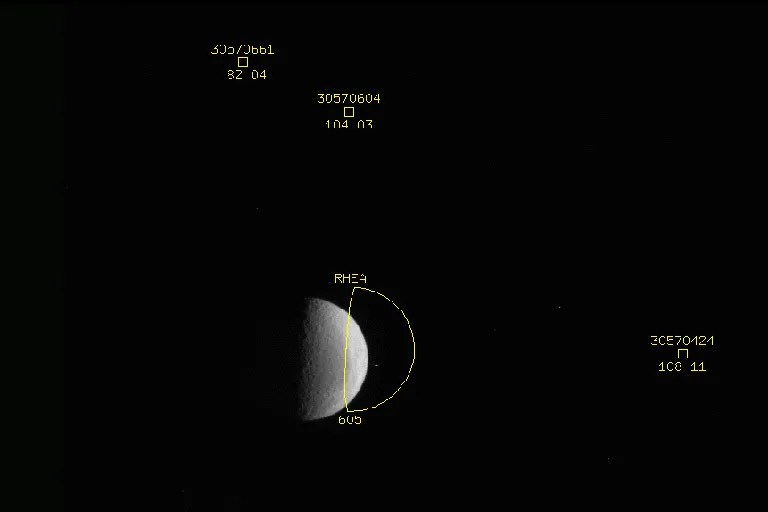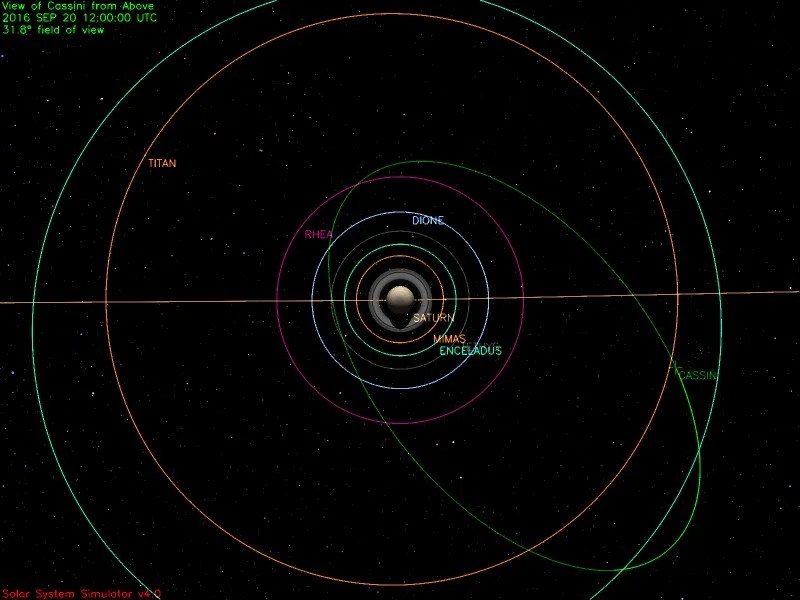6 min read

Cassini took its final “OpNav” image this week. Optical Navigation employs a unique system to provide data for improving estimates of the spacecraft's orbit, and for tracking the orbital behavior of selected natural satellites. It consists of images that the spacecraft takes and returns via telemetry as digital bits. OpNavs are used relatively infrequently, but they have extraordinary value, as mentioned below under Tuesday's activity. More commonly Navigation uses radiometric data, Doppler and Range from the Deep Space Network (DSN). This is obtained for hours at a time during virtually every scheduled DSN tracking session. The Doppler shift in the continuous radio link between spacecraft and DSN reveals speed. Sending and receiving special tones provides Range, or distance. Both measurements reveal the spacecraft's continuously changing location in the line of sight, but OpNavs address additional dimensions and help increase navigational accuracy.
Wednesday, Sept. 14 (DOY 258)
The Imaging Science Subsystem (ISS) made a 90-minute Titan monitoring observation, with the Visible and Infrared Mapping Spectrometer (VIMS) and the Composite Infrared Spectrometer (CIRS) riding along.
ISS continued controlling spacecraft pointing for another nine hours, first to inspect Saturn's thin bright crescent limb for five hours, with VIMS and the Ultraviolet Imaging Spectrograph (UVIS) as riders. The remaining four hours went into a study of Saturn's southern auroral region near the pole, with CIRS, VIMS, and UVIS riding along. Finally today, CIRS led an observation, with VIMS, mapping Saturn in far-infrared wavelengths for 12 hours.
The extraordinary view Cassini had of the majestic planet today is simulated here.
Thursday, Sept. 15 (DOY 259)
Today marks one year before Cassini's enormously productive mission comes to a close with the Grand Finale. The story, and the ticking countdown clock, may be seen here: /news/12939/cassini-begins-epic-final-year-at-saturn .
VIMS spent 13.6 hours making a Saturn global map in the infrared part of the spectrum, at high phase angle, covering the planet from low latitudes up to the polar regions. CIRS rode along.
Today the Cassini project scientist gave a presentation on "Cassini’s Science: Past and Future," to the Committee on Astrobiology and Planetary Science (CAPS) of the Space Studies Board of the National Academies of Science, Engineering and Medicine, in Irvine, California. The Planetary Society's "Planetary Radio" also featured an interview with the scientist: http://go.nasa.gov/2d5oesG .
Helping mark the start of Cassini's final year of existence, NASA's Astronomy Picture of the Day today illustrates how Saturn wanders backwards for a while each year, as do Mars and other planets, across our sky: http://apod.nasa.gov/apod/ap160915.html .
Friday, Sept. 16 (DOY 260)
UVIS, CIRS and VIMS jointly observed Saturn’s northern aurora for 10.4 hours today.
Saturday, Sept. 17 (DOY 261)
ISS kept its telescopes trained on Saturn's thin, bright F ring for 16 hours today, taking images that the Imaging Science team will use as a movie.
Sunday, Sept. 18 (DOY 262)
ISS, CIRS and VIMS looked back to Jupiter, whose enormous orbital momentum contributed one last increment of gravity-assist boost to Cassini in December 2000, en route to Saturn. Today's 14 hours of photometry and polarimetry will provide a point of comparison for non-Cassini astronomical observations of brown dwarfs and giant extrasolar planets. It is a companion observation to the one that occurred last December.
While observing Jupiter, Cassini coasted through apoapsis, marking the start of its orbit #243 of Saturn. The spacecraft's altitude and speed were similar to those during the Aug. 25 apoapsis passage.
After the Jupiter observation, ISS turned to make a two-minute storm-watch observation on Saturn. Another one took place on Tuesday with VIMS participating; another took place on Saturday at the conclusion of the F ring movie.
Monday, Sept. 19 (DOY 263)
The Cosmic Dust Analyzer (CDA) took advantage of the high altitude near apoapsis to perform a 13-hour observation of exogenous dust, particles originating from outside the Saturn system.
Saturn's F ring appears along the bottom of an image featured today; the broad ring above it is the A ring, with its narrow Keeler gap visible, and the wider Enke gap sporting its own ringlets and tiny moon: /resources/17503 .
Tuesday, Sept. 20 (DOY 264)
CIRS observed Saturn’s atmosphere for 12 hours to determine the upper-troposphere and tropopause temperatures while the planet rotated. When this was done, the Navigation team used ISS for 90 minutes to obtain one final set of optical navigation (OpNav) images. Saturn's large icy moon Rhea was the target, with the exposure set to capture the background stars for reference.
Since October 2003, nine months before Cassini's arrival in Saturn orbit, a total of 2,817 OpNav images have been taken. Thirteen years of obtaining and processing optical navigation images have vastly increased our knowledge of the orbits and gravitational interactions of Saturn's eight largest satellites.
Pictures of a natural satellite taken by the spacecraft's camera, with stars in the background, reveal the direction to that satellite at a point in time, and a sequence of such pictures over time produces more accurate estimates of their orbits. Indeed, without such detailed knowledge of orbits and gravitational interactions, Cassini's very low flybys through the plumes of Saturn's small moon Enceladus -- as low as 25 km above the surface of this icy satellite -- would never have been attempted.
The orbits of many of Saturn's moons, which before Cassini had been known to no better than 1,000 kilometers, are now known in some cases to better than 5 km, thanks to having combined OpNavs with radiometric data from the DSN.
Wrapping up the science activities for this week, ISS made a 60-minute observation as part of the satellite orbit campaign to identify small objects near the planet.
A three-day joint meeting the Cassini Plasma Spectrometer team and the Ion and Neutral Mass Spectrometer team began today at the Southwest Research Institute in San Antonio, Texas.
Solid-state chemistry might be playing a part in the formation of an unusual ice cloud in Titan's atmosphere: /news/12941/nasa-scientists-find-impossible-cloud-on-titan-again .
Cassini's website is featuring a discussion of the mission's major discoveries: https://saturn.jpl.nasa.gov/science/saturn along with a recap of the mission to date: /news/12938/recap-september-11-16-2016 .
The Deep Space Network communicated with and tracked Cassini seven times this week, using stations in Australia and California. A total of 35 individual commands were uplinked, and about 1,280 megabytes of telemetry data were downlinked and captured at rates as high as 124,426 bits per second.
Wrap up:
Cassini is orbiting Saturn with a period of 12 days in a plane inclined 53.7 degrees from the planet's equatorial plane. The most recent spacecraft tracking and telemetry data were obtained on Sept. 21, using the 70-meter diameter DSN station in Australia. The spacecraft continues to be in an excellent state of health with all of its subsystems operating normally except for the instrument issues described at http://saturn.jpl.nasa.gov/anomalies .
Cassini's path up to mid-day Sept. 20 is illustrated here: http://go.nasa.gov/2cEt6BE .
Milestones spanning the whole orbital tour are listed here: https://saturn.jpl.nasa.gov/mission/saturn-tour/tour-dates .
Information on the present position and speed of the Cassini spacecraft may be found on the "Present Position" page at:
https://saturn.jpl.nasa.gov/mission/saturn-tour/where-is-cassini-now .
This illustration shows Cassini's path up to mid-day Sept. 20, 2016








